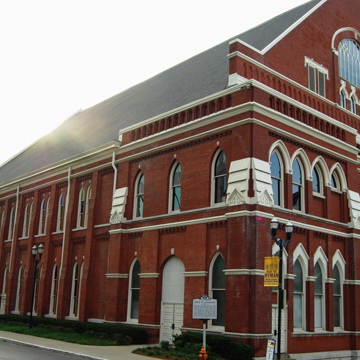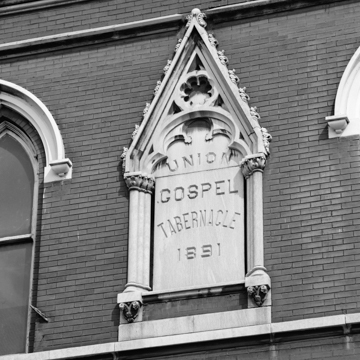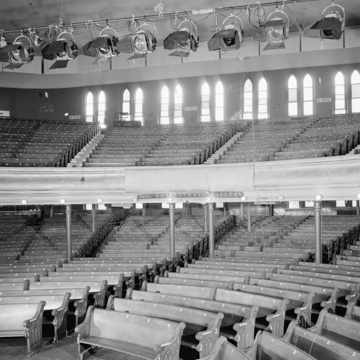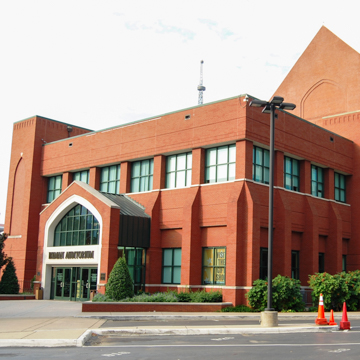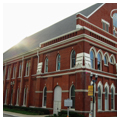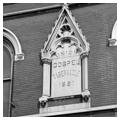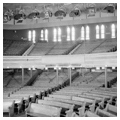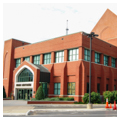You are here
Ryman Auditorium
Ryman Auditorium was built as the Union Gospel Tabernacle but was home to the Grand Ole Opry from 1943 to 1974. The building is located just off Broadway, a major thoroughfare, in downtown Nashville. It is one of the most important properties associated with the growing popularity of twentieth-century American country music. While the origins of modern country music can be disputed, the importance of “The Mother Church of Country Music,” the Ryman’s sobriquet, is indisputable. Here, live performances and radio broadcasts of the Grand Ole Opry pushed country music into the mainstream of American popular culture.
Riverboat captain Thomas Ryman attended one of the Reverend Thomas Jones’s revival meetings in Nashville in 1885 and immediately became an ardent follower. Ryman worked to raise funds for Jones to have a permanent location for his services. The result was the Union Gospel Tabernacle. Begun in 1888 and completed in 1892, the two-and-one-half-story, Gothic Revival, load-bearing brick building was embellished with limestone trim, pointed-arched windows, and corbelled brick trim. Inside are two levels of wooden pews for 3,000 people. The pews are curved to face the orchestra, evoking the seating arrangement of an ancient Greek theater.
The building was designed for church services, but soon became a venue for lectures, speeches, and public meetings. In 1897, the addition of the Confederate Gallery, donated by the Confederate Veterans Association during Tennessee’s centennial celebration, doubled the building’s seating capacity. When New York’s Metropolitan Opera was scheduled to perform in the building in 1901, the pulpit area was changed to a stage, reducing seating to 3,500. After Ryman’s death in 1904, Union Gospel Tabernacle was renamed to honor of Ryman’s fundraising efforts.
Nashvillian Hugh Cathcart Thompson (1829–1919) designed the building. Listed as a carpenter in the 1860 census, Thompson worked alone or in partnership with others on numerous public buildings and private residences in and around Nashville. Thompson was also an alderman for Edgefield (now part of Nashville), an elder in the Cumberland Presbyterian Church, a Knight Templar, and a member of the Mechanics’ and Manufacturers’ Association and the Nashville Chamber of Commerce.
As one of the larger venues in Nashville, Ryman Auditorium hosted a variety of events. Actress Sarah Bernhardt was on the Ryman stage in 1906; President Theodore Roosevelt spoke here in 1907, as did President William Howard Taft in 1911; singer Marian Anderson performed at the Ryman in 1932; and First Lady Eleanor Roosevelt spoke here in 1938. The most noteworthy event held in the Ryman Auditorium occurred in 1943 when the Grand Ole Opry radio show was first broadcast from the building.
National Life and Accident Insurance Company began WSM Radio in 1925 as a way to advertise their company and its products. Among its programming was the music show WSM Barn Dance. Two years later, in 1927, program director and announcer George Hay christened the show the Grand Ole Opry, distinguishing it from classical music played at the station. As the Grand Ole Opry show’s popularity increased and people came into the studio to listen to the broadcasts, National Life and Accident Insurance decided that a larger venue was needed and after several moves, came to the Ryman Auditorium. Among the country and bluegrass stars who came into prominence here are Lester Flatt, Minnie Pearl, Hank Williams, Earl Scruggs, and Bill Monroe. Performers like Elvis Presley and Spike Jones also played here, but it was country music and the Grand Ole Opry that gave the Ryman Auditorium national significance in music history.
Throughout the years of the Opry’s occupation, minor changes were made to interior spaces of the building, especially in the dressing rooms and backstage. Deferred maintenance, lack of air conditioning, changing demographics in downtown Nashville, and the desire for more profit, led the owners of the Ryman Auditorium to plan a country music theme park in suburban Nashville. Their plan’s for Opryland also included the demolition of Ryman Auditorium, with its bricks used to erect a “Little Church in Opryland” as part of the theme park. A new Grand Ole Opry House was built in suburban Nashville in 1972–1974, but protests from the public and local and national preservation groups saved the historic Ryman Auditorium from demolition. The building was open primarily only for tours until 1992–1994 when the interior was renovated and a modern support building addition was placed on the rear (east) elevation of the building. Another expansion, attached to the 1992–1994 addition, is planned for the building.
References
Havighurst, Craig. Air Castle of the South: WSM and the Making of Music City. Chicago: University of Illinois Press, 2007.
Historic American Buildings Survey. “Union Gospel Tabernacle.” Accessed August 11, 2014. http://www.loc.gov/pictures/item/tn0030/.
Howell, William W. “Hugh Cathcart Thompson: Native Tennessee Architect.” Master’s thesis, University of Tennessee School of Architecture, 1975.
Miele, Frank J., “Ryman Auditorium,” Davidson County, Tennessee. National Historic Landmarks Nomination Form, 2000. National Park Service, U.S. Department of the Interior, Washington, DC.
Writing Credits
If SAH Archipedia has been useful to you, please consider supporting it.
SAH Archipedia tells the story of the United States through its buildings, landscapes, and cities. This freely available resource empowers the public with authoritative knowledge that deepens their understanding and appreciation of the built environment. But the Society of Architectural Historians, which created SAH Archipedia with University of Virginia Press, needs your support to maintain the high-caliber research, writing, photography, cartography, editing, design, and programming that make SAH Archipedia a trusted online resource available to all who value the history of place, heritage tourism, and learning.

